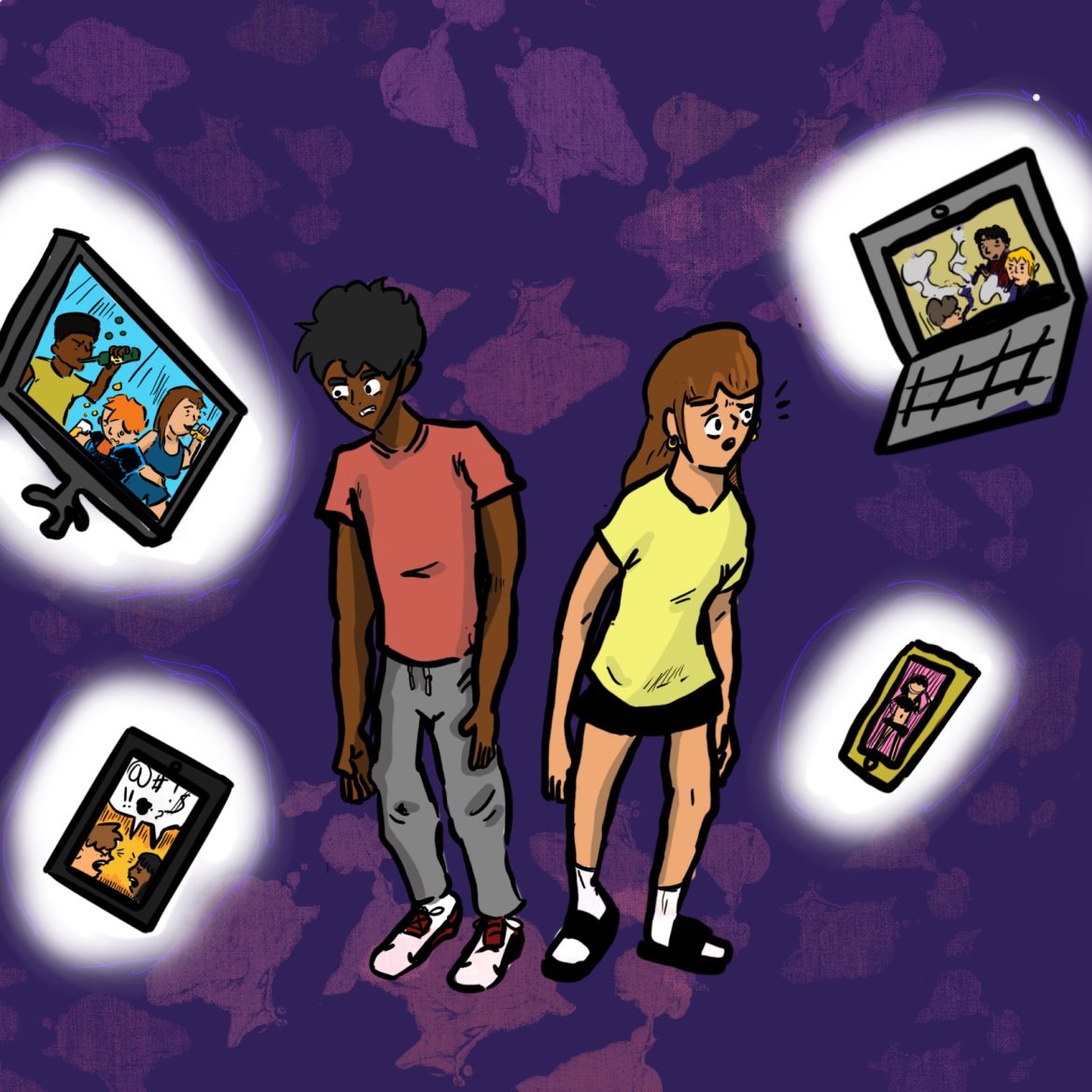Two teenagers stand together as various forms of negative teenage representation float around them. Popular media currently portrays high school students negatively, which had a predictably adverse impact on Gen Z. “It’s the responsibility of media executives to put more thought into their characters and actors to know the effect they have in popular media,” Atchley wrote. “If more TV shows and movies were honest about how high schoolers truly behave, younger generations would be seen more positively by peers – and themselves.” Illustration by Sam Harwell
Popular media portrays teenagers as oversexualized, drugged out, and lazy. This perception harms high schoolers and good representation is hard to find.
“There is not a thing on the planet Earth that compares to fentanyl.” That’s a real line spoken by 26-year-old actress Zendaya, who portrays 17-year-old Rue Bennett on the TV series “Euphoria.”
While lines like this may at first seem to be a harmless dramatization, the reality is that adult shows like “Euphoria” negatively impact kids and teenagers who consume the content nonetheless.
Other popular shows, like “Do Revenge,” “Ginny and Georgia” and “Riverdale” glamorize oversexualizing teenagers, committing crimes and using drugs with their one-dimensional characters.
“Stereotypes are being used to box teenagers in without offering depth: the jock that has feelings, the bad boy with a painful childhood, the goody-two-shoes virgin, the airhead cheerleader. These roles take away the complexity of a teenager, making their high school role their defining trait,” according to a May 2021 Seattle Times article.
These tropes are imprinted on kids through the use of older actors to portray younger characters, which creates unrealistic standards for what a teenager should look or act like at their age.
These tropes are imprinted on kids through the use of older actors to portray younger characters, which creates unrealistic standards for what a teenager should look or act like at their age.
According to the Body Positive Alliance, a student-led organization advocating for body inclusivity, the average age disparity between actors and teenagers in popular media is eight years. Along with this age difference comes different expectations and experiences, which can cause young adults to begin to compare themselves to popular figures in an unhealthy way.
Another prevalent case of oversexualization stemming from this age gap is in the hit television show “Riverdale.” In the series, 16-year-old Betty Cooper – played by 20-year-old Lily Reinhardt – performs a strip show at a biker bar, while 15-year-old Archie Andrews – played by 19-year-old KJ Apa – has a relationship with one of his teachers.
The truth is, most high schoolers simply don’t engage in those kinds of activities, as they fluctuate between lots of identities during high school. Many of these harmful ideas are forced upon teenagers in flashy, popular media, which pollutes this development process.
“(In popular media), you must show the extreme and show the amazing, but I also like to show all the in-betweens. I don’t want to be all these amazing or terrible standards because people don’t always fit into those boxes”
— Callie Wallace,
freshman
“(In popular media), you must show the extreme and show the amazing, but I also like to show all the in-betweens. I don’t want to be all these amazing or terrible standards because people don’t always fit into those boxes,” Clarke Central High School freshman Callie Wallace said.
Teenagers deserve fair and positive representation. Shows such as “Heartstopper,” “Moxie” and “To All The Boys I’ve Loved Before” all do a much better job of accurately representing the multifaceted nature of the teenage experience.
It’s the responsibility of media executives to put more thought into their characters and actors to know the effect they have in popular media. If more TV shows and movies were honest about how high schoolers truly behave, younger generations would be seen more positively by peers – and themselves.
